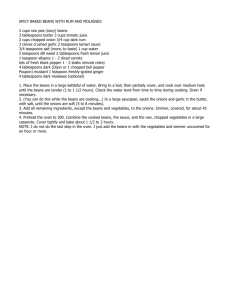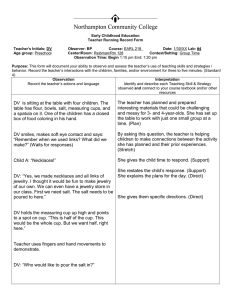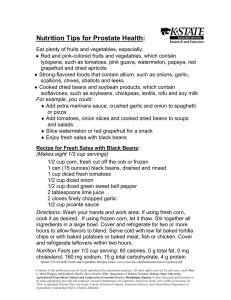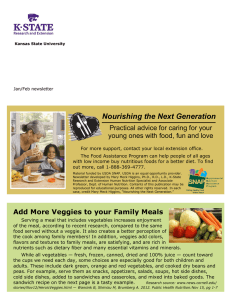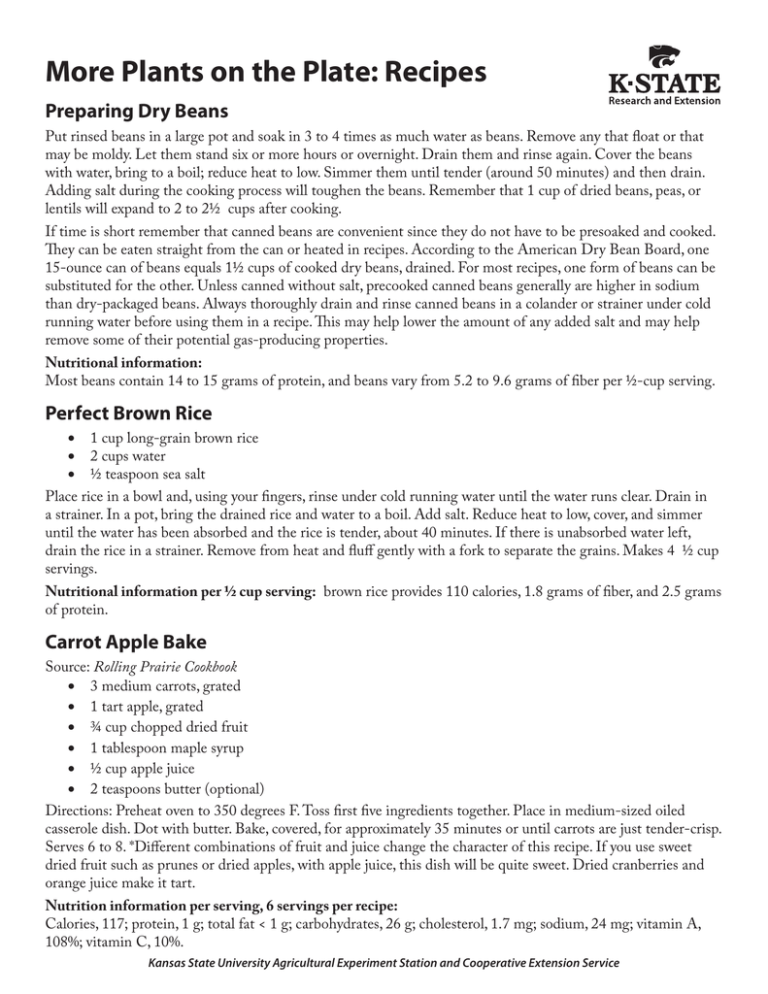
More Plants on the Plate: Recipes
Preparing Dry Beans
Put rinsed beans in a large pot and soak in 3 to 4 times as much water as beans. Remove any that float or that
may be moldy. Let them stand six or more hours or overnight. Drain them and rinse again. Cover the beans
with water, bring to a boil; reduce heat to low. Simmer them until tender (around 50 minutes) and then drain.
Adding salt during the cooking process will toughen the beans. Remember that 1 cup of dried beans, peas, or
lentils will expand to 2 to 2½ cups after cooking.
If time is short remember that canned beans are convenient since they do not have to be presoaked and cooked.
They can be eaten straight from the can or heated in recipes. According to the American Dry Bean Board, one
15-ounce can of beans equals 1½ cups of cooked dry beans, drained. For most recipes, one form of beans can be
substituted for the other. Unless canned without salt, precooked canned beans generally are higher in sodium
than dry-packaged beans. Always thoroughly drain and rinse canned beans in a colander or strainer under cold
running water before using them in a recipe. This may help lower the amount of any added salt and may help
remove some of their potential gas-producing properties.
Nutritional information:
Most beans contain 14 to 15 grams of protein, and beans vary from 5.2 to 9.6 grams of fiber per ½-cup serving.
Perfect Brown Rice
• 1 cup long-grain brown rice
• 2 cups water
• ½ teaspoon sea salt
Place rice in a bowl and, using your fingers, rinse under cold running water until the water runs clear. Drain in
a strainer. In a pot, bring the drained rice and water to a boil. Add salt. Reduce heat to low, cover, and simmer
until the water has been absorbed and the rice is tender, about 40 minutes. If there is unabsorbed water left,
drain the rice in a strainer. Remove from heat and fluff gently with a fork to separate the grains. Makes 4 ½ cup
servings.
Nutritional information per ½ cup serving: brown rice provides 110 calories, 1.8 grams of fiber, and 2.5 grams
of protein.
Carrot Apple Bake
Source: Rolling Prairie Cookbook
• 3 medium carrots, grated
• 1 tart apple, grated
• ¾ cup chopped dried fruit
• 1 tablespoon maple syrup
• ½ cup apple juice
• 2 teaspoons butter (optional)
Directions: Preheat oven to 350 degrees F. Toss first five ingredients together. Place in medium-sized oiled
casserole dish. Dot with butter. Bake, covered, for approximately 35 minutes or until carrots are just tender-crisp.
Serves 6 to 8. *Different combinations of fruit and juice change the character of this recipe. If you use sweet
dried fruit such as prunes or dried apples, with apple juice, this dish will be quite sweet. Dried cranberries and
orange juice make it tart.
Nutrition information per serving, 6 servings per recipe:
Calories, 117; protein, 1 g; total fat < 1 g; carbohydrates, 26 g; cholesterol, 1.7 mg; sodium, 24 mg; vitamin A,
108%; vitamin C, 10%.
Kansas State University Agricultural Experiment Station and Cooperative Extension Service
Nutty Rice and Broccoli
Source: Cooking the Whole Foods Way, by Christina Pirello
• 2 cups short grain brown rice
• 21/2 cups water
• 1 onion diced
• 3 to 4 carrots, diced
• 2 cups fresh broccoli, cut into flowerets; dice stem as well
• ½ cup walnuts
• 1 teaspoon brown rice miso dissolved in a small amount of water
Combine rice and water in a pressure cooker. Bring to a boil, loosely covered, over medium heat. Add salt, seal
and bring to full pressure. Reduce heat to low and cook for 45 minutes. Remove from heat and allow pressure to
reduce naturally.
While the rice is cooking, bring a pan of water to a boil. Separately cook broccoli, carrot, and onion in boiling
water until crisp-tender. Cool in iced water and drain. Mix vegetables together in a medium bowl. Set aside.
Heat a dry skillet over medium heat. Add the walnuts and pan-toast until fragrant, about 5 minutes, stirring.
Puree walnuts and miso until a coarse paste forms. Stir vegetables, walnut paste, and lemon peel into rice.
Transfer to a serving bowl. Makes 6 to 8 servings.
Nutrition Information per serving:
Calories, 330; protein, 9 g; total fat, 9 g; carbohydrates, 62 g; dietary fiber, 8 g; sodium, 75 mg.
Penne with Broccoli and Raisins
Source: Cooking the Whole Foods Way, by Christina Pirello
• ¼ cup raisins
• ¼ cup extra virgin olive oil
• 2 or 3 cloves garlic, minced
• 1 large onion, minced
• Sea salt
• ½ cup pine nuts or walnuts
• 1 head broccoli, cut into small flowerets, with stems cut into fine matchsticks
• 8 ounces penne pasta
• Fresh parsley or basil, minced (optional)
Soak raisins in warm water for 10 minutes; then drain. Heat the oil in a skillet over medium heat. Add the
garlic, onion, and a pinch of salt and cook, stirring occasionally, until the onion is transluscent, about 3 minutes.
Add nuts and sprinkle lightly with salt. Cover, reduce heat and allow to simmer while pasta cooks.
Bring large pan of water to a boil and cook pasta according to directions on package. Add broccoli to the pot
and cook with pasta until pasta is tender and broccoli is bright green. Drain well; do not rinse. Toss pasta and
broccoli with onion mixture and raisins and serve garnished with fresh parsley or basil if desired. Makes 6
servings.
Nutrition Information per serving:
Calories: 360, protein: 9 g; total fat, 17 g; carbohydrates, 45 g; dietary fiber, 7 g; sodium, 60 mg.
Quinoa with Dried Cranberries, Apricots, and Pecans
Source: The New American Plate Cookbook
Quinoa (pronounced “keen-wah”) may be a delicate grain, but it is one of the best sources of plant protein. It
also provides iron, potassium, folate, and several minerals. It is important to thoroughly rinse quinoa before
cooking to avoid a bitter flavor. Sweetened with dried fruits, thyme, and pecans, as in this recipe, quinoa can add
a unique twist to your New American Plate. Makes 6 servings.
• 2 cups vegetable broth or water
• 1 cup quinoa, thoroughly rinsed and drained
• Pinch of salt (optional)
• ¼ cup dried cranberries
• ¼ cup diced dried apricots
• 2 tablespoons minced fresh thyme leaves
• ¼ cup finely chopped toasted pecans
In a medium saucepan, bring the broth to a boil. Add the quinoa and salt. Reduce heat to low, cover and
simmer for 12 to 15 minutes, until all the liquid is absorbed. Stir the cranberries, apricots, and thyme into the
hot quinoa. Top with pecans and serve hot or cold.
Nutritional information per serving:
Calories: 177 calories; total fat, 5 g (less than 1 g saturated fat; carbohydrates, 28 g; protein, 5 g; dietary fiber, 3 g;
sodium, 156 mg.
Roasted Red Pepper Hummus
Source: The New American Plate Cookbook
This tangy appetizer takes only minutes to prepare. Toasted wedges of whole wheat pita bread are one
good vehicle for this dip. Or use it as a spread on sandwiches, piling on a variety of colorful vegetables for a
phytochemical feast. You may substitute 1¼ cup cooked beans for each 15-ounce can. Tahini, a Middle Eastern
paste, is made from sesame seeds. Look for tahini in the ethnic section of your supermarket.
• 1 jar (7 ounces) red peppers, drained
• 1 can (15 ounces) chickpeas, drained and rinsed
• 1 can (15 ounces) cannellini (white kidney) beans, drained and rinsed
• ¼ cup tahina (sesame paste)
• 2 garlic cloves, minced
• 2 tablespoons freshly squeezed lemon juice, or to taste
• 1 teaspoon ground cumin
• Pinch of salt and freshly ground black pepper
In a food processor or blender, combine all of the ingredients except the salt and pepper. Process the mixture
until smooth. Season to taste with salt and pepper. Serve chilled or at room temperature with warmed whole
wheat pita wedges. Makes 24 servings. (2 tablespoons per serving)
Nutritional information per serving:
Calories, 50; total fat, 2 g (less than 1 gram saturated fat); carbohydrates, 7 g; protein, 2 g; dietary fiber, 2 g;
sodium, 104 mg.
Marvelous Minestrone
Source: Rolling Prairie Cookbook
• 2 tablespoons olive oil
• 4 to 6 cloves garlic, minced
• 1 large onion, chopped
• 2 medium carrots, chopped
• 4 to 5 stalks celery, chopped
• 2 tablespoons chopped fresh parsley
• 4 to 6 tablespoons fresh basil, chopped (or 2 teaspoons dried)
• 1 teaspoon dried oregano
• 1 teaspoon black pepper
• 1 teaspoon salt
• 3 ½ tablespoons red wine vinegar
• 2 tablespoons honey, brown sugar or brown rice syrup
• 5 to 7 cups water or stock
• 4 medium sized fresh tomatoes, diced (or 1 ½ cups canned diced tomatoes)
• 1 ½ cup green beans, cut or snapped into 1 inch pieces
• 2 cups cooked kidney beans, rinsed and drained
• 4 ounces broken spaghetti, cooked
Heat olive oil in a large soup pot over medium heat. Add the garlic, onion, carrots, celery, parsley, basil, and
oregano and saute several minutes, until fragrant. Add pepper, salt, vinegar, sweetener, water or stock, tomatoes,
and green beans. Bring to a boil, then reduce heat to low and simmer until vegetables are tender but not falling
apart, approximately 30 minutes. Add the kidney beans and cooked pasta and heat through. If the soup is too
thick at this point, add more water or stock to thin it. Serve with freshly grated Parmesan cheese, crust French
bread, and a crisp green salad — an excellent meal to share with friends. Serves 8 (1-cup servings).
Nutrition information per serving, 8 servings per recipe:
Calories, 213; protein, 7 g; gotal fat, 3.7 g (saturated fat, <1g); carbohydrates, 37 g; cholesterol, 0 mg; sodium,
297 mg; vitamin A, 55%; vitamin C, 23%.
Recipes in this guide are reprinted with permission from:
Cooking the Whole Foods Way, by Christina Pirello, Copyright 1997, 2007 by Christina Pirello, Published by
Penguin Group USA.
Rolling Prairie Cookbook, by Nancy O’Connor, Copyright 1998. Published by Spring Wheat Nutrition
Education Services.
The New American Plate Cookbook, University of California Press, Copyright 2005, American Institute for Cancer
Research.
Contents of this publication may be freely reproduced for educational purposes. All other rights reserved.
Publications from Kansas State University are available at: www.ksre.ksu.edu
Kansas State University Agricultural Experiment Station and Cooperative Extension Service
K-State Research and Extension is an equal opportunity provider and employer. Issued in furtherance of Cooperative Extension Work, Acts of May 8
and June 30, 1914, as amended. Kansas State University, County Extension Councils, Extension Districts, and United States Department of Agriculture
Cooperating, Gary Pierzynski, Interim Director.


